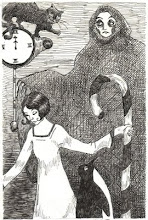
 Gilda Gray was a vaudevillian, a chorus girl, a headliner in The Follies and at the Palace, and a movie star.
Gilda Gray was a vaudevillian, a chorus girl, a headliner in The Follies and at the Palace, and a movie star.Now, of course, she's pretty much forgotten. Doing all this research on these former chorus girls and silent movie stars, there's one thing I'm finding particularly telling: at least half are mentioned as being "possibly the model for Norma Desmond". I picture Hollywood in the fifties being filled with strange and lovely aging goddesses who still live on cigarettes and gin. In some ways Gilda was one of them, but at heart, she was a trouper.
Born in Poland in 1901 (or thereabouts: to paraphrase Angela Carter, the birthdate of actresses is often a movable feast), her parents were killed when she was an infant, but she was luckily adopted out of the orphanage by a couple who moved with her to Milwaukee when she was 9 or 10 (or thereabouts: see above). She began her career singing and dancing in local saloons. She married when still in her early teens, had a son, got divorced and went on the road. She danced what was called (and is still called) The Shimmy. People went wild for her.
She went by a variety of names until none other than the great Sophie Tucker suggested she use the name "Gilda" because of her golden blonde hair. This was in 1919. She did, and it stuck. Gilda Gray is a far better theatrical moniker than Marianna Winchalaska, the name she was born with. She was a success in vaudeville, which led her to be hired by Florenz Ziegfeld, and in the Follies, she truly became a star. In 1923 she headed to Hollywood where she was immediately successful. Her movies were huge hits and she made lots of money, and like most true show biz success stories of the age, she was a world class workaholic.
In 1929, she lost most of her accumulated fortune in the crash, and couldn't get much movie work as her thick Polish accent was not deemed talkie friendly. So, she went back to vaudeville, where she got a booking at The Palace in New York at $3,500 a week in depression dollars. She also made some movies in England, one of which, Piccadilly, has been recently restored. I watched it a few weeks ago, and - it's not very good. In general, the English silents are pretty deadly, and this one is no exception. It's painfully slow-moving and Gilda isn't great in it. From what I gather, she was neither a great actress or a great dancer: what people came in droves to see was a pretty young woman shaking with orgasmic delight in an otherwise fairly staid world.
She had a heart attack in 1931, largely brought on by overwork. Any sort of comeback was hindered by poor health. She shot a few scenes, playing herself in The Great Ziegfeld in 1936, but her scenes were cut from the final film. She continued to perform in nightclubs when she could, got married and divorced a few times, and did some very admirable work during the war on behalf of Poland.
She died of a second heart attack in 1958, all but forgotten. The Motion Picture Relief Fund paid for her funeral.


















No comments:
Post a Comment